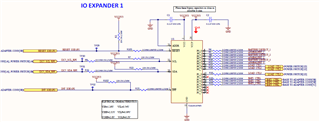Other Parts Discussed in Thread: TPS22960, , PCF8574, TCA9554, TCA9554A, TCA9555, PCF8574A, PCA9554A, PCA9555, PCA9554, PCF8575
Tool/software:
Hello,
We have used TPS22960 in our project. We have made schematic as per reference circuit from its datasheet. Can anyone from TI verify this schematic & let us know whether this will work or need some modifications.



